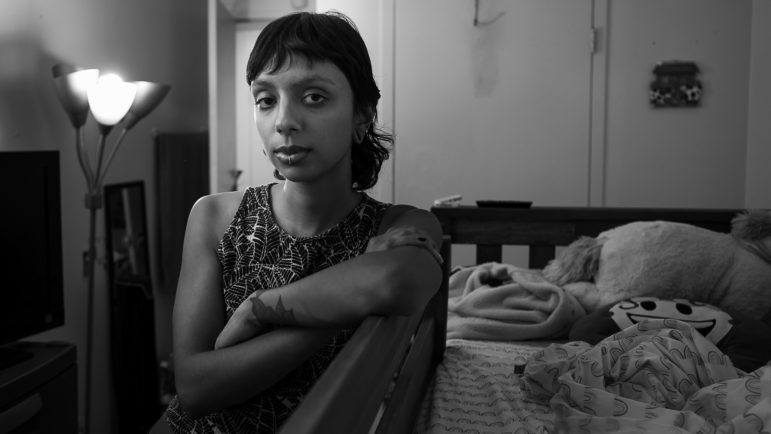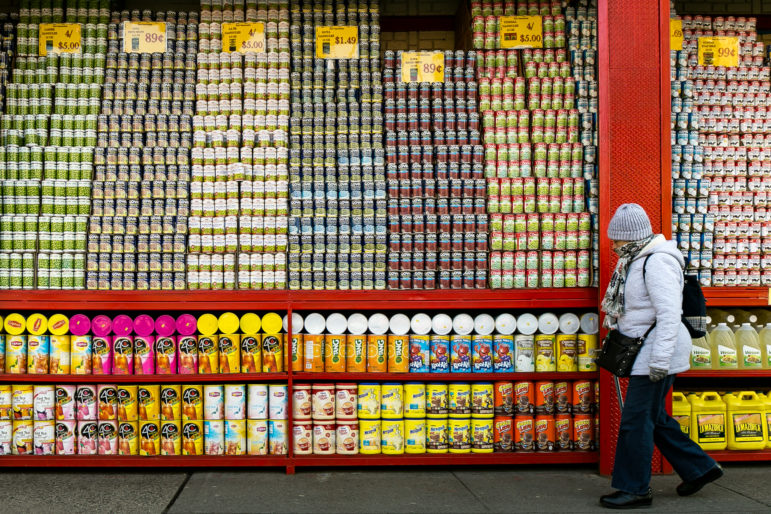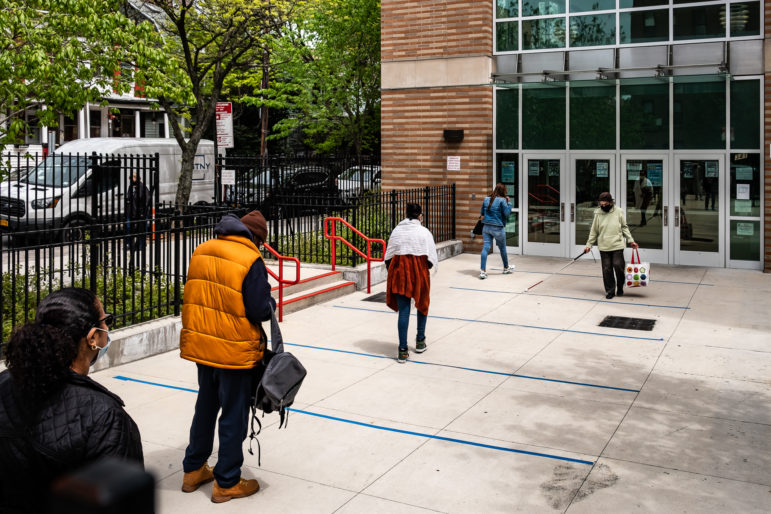The city’s Human Resources Administration (HRA) failed to promptly process four of every 10 food stamp applications during fiscal year 2022, when the rate of timely processing plummeted from about 92 percent in fiscal year 2021 to just over 60 percent.

Adi Talwar
Bianca Herrera in her apartment in the Bronx. The mother of two said she spent more than year trying to get her family’s food stamps recertified. “It was truly devastating wondering how I was going to be able to buy food every day.”
Chronic delays in food stamp application processing left thousands of low-income New Yorkers scrambling to pay for groceries while they waited for their benefits to come through last year, city data shows.
The city’s Human Resources Administration (HRA) failed to promptly process four of every 10 applications for Supplemental Nutrition Assistance Program (SNAP) benefits, commonly known as food stamps, during the 2022 fiscal year, according to the annual Mayor’s Management Report. The rate of timely processing—considered a “critical indicator” of agency performance— plummeted from about 92 percent in fiscal year 2021 to just over 60 percent in the fiscal period spanning July 1, 2021 to June 30 of this year.
The monthly benefits are issued electronically onto a card, which recipients, who qualify based on their income, can use to purchase groceries at supermarkets, bodegas and farmers markets. SNAP is considered the most important anti-hunger program in the country, but any delay can have an immediate and tangible impact on families in need. Applicants already approved for the benefits have to recertify them at regular intervals—and slow processing times mean households can abruptly lose access to funds they rely on.
“It’s a lot of people going through this right now,” said a Crown Heights mother named Thompson, who asked not to use her first name because she is a survivor of domestic violence. “They’re people who are pregnant, people who have kids, people who can’t make ends meet but they’re trying to.”
Thompson, 27, said she waited nearly a month for her family’s $600-a-month SNAP benefits to come through after recertifying them in September. As the weeks dragged on, she said she was forced to pawn her tablet and jewelry, including her new engagement ring, to come up with some extra cash for food. The items are still sitting in a Brooklyn pawn shop because she cannot yet afford to buy them back, she said. She hasn’t told her fiance where her missing ring is.
HRA blamed the 30-percent decline in timely processing on “unprecedented increases in applications and the end of federal waivers that had delayed recertifications” the previous year. During the COVID-19 pandemic, the federal and state government allowed SNAP recipients to skip recertification interviews while continuing to receive their crucial benefits.
More than 1.7 million New Yorkers across 1 million households received food stamps last fiscal year, a slight decrease from 2021, the mayor’s report shows. The number of SNAP applicants soared during the pandemic, when unemployment reached 16.2 percent in New York City, thousands of businesses closed and many New Yorkers struggled to find consistent work that paid a living wage. Over the past two years, the number of new applicants rose by more than 50 percent compared to the 2019 fiscal year, HRA said.
At the same time, HRA lost hundreds of employees, a problem common throughout the municipal workforce since the start of the pandemic. About 15 percent of HRA’s 13,044 budgeted positions were vacant on Dec. 31, 2021, the middle of the last fiscal year, according to information provided by the city’s Independent Budget Office (IBO).
The problem has only gotten worse: As of Oct. 31 of this year, another 710 positions went unfilled, driving the staff vacancy rate to around 20 percent, IBO’s data shows.
Despite the staffing issues and application volume, HRA said agency staff still managed to connect more households to SNAP than in recent years. But that’s little comfort to New Yorkers who struggled to feed their families without immediate access to the benefits they are entitled to.

Adi Talwar
A supermarket in Inwood.Bronx resident Bianca Herrera, 26, said she tried to get her family’s food stamps back for more than a year after a recertification error by HRA cut them off. Herrera, a single mother with two young daughters, said she was denied an in-person appeal known as a Fair Hearing to dispute the termination. She said the automated processes made it hard for her to talk to an actual person to resolve the problem.
“After repeatedly having to go to the [benefit office] and pleading to get my SNAP reopened, they basically only gave me fake promises,” she said. “I felt invisible every time I went in there.”
Herrera said she finally got the food stamps and a year of retroactive benefits on Wednesday, while City Limits was reporting this story. For months, she said, she was forced to borrow money from friends and relatives because her part-time job could not make up for the lost benefits.
“That all took a toll on me. It was truly devastating wondering how I was going to be able to buy food every day,” she said. “That was a constant worry. It was insane.”
For Leslie Martinez and her family of five, the wait was three days at the start of this month. But even that seemingly short delay forced her to draw from the $200 in cash assistance she receives each month, and disrupted her family’s precarious budget for the rest of November.
“Everything is so expensive,” she said, citing inflation that has raised average grocery prices 13 percent over the past year. “I’m trying to make the best of what I have. I go for the cheapest stuff, go to the cheapest location.”
She said she lost her job at a Bronx Dollar Tree when the store closed last year and has since struggled to buy affordable food. The pantries in her area do not provide enough sustenance, she said.
As food stamp delays worsened, the timely processing of cash assistance—small monthly payments for the lowest-income New Yorkers—also dropped from 95.4 percent in fiscal year 2021 to 82.3 percent last year. Cash assistance processing is also considered a “critical indicator” of agency performance.

Adi Talwar
Hunger and food insecurity quickly emerged as one of the most pressing problems facing New Yorkers during the pandemic. Here, residents lined up at one of the city’s free meal hubs in May 2020.
SNAP benefits are funded entirely by the federal government, with states and local municipalities covering the costs to administer the program. In addition to helping families buy food, the benefits have an important economic function: food stamp payments are immediately reinvested into local businesses.
But the lag time can be destabilizing to a growing number of New Yorkers at the margins, said Adriana Mendoza, benefits supervisor at the Safety Net Project. Mendoza and her team have worked with Herrera, Martinez and Thompson to restore their benefits.
Over the past year, Mendoza said the organization has seen a “huge influx” of families waiting 60 days or more to access SNAP benefits because of processing delays.
“Families are struggling to put food on the table especially with rising costs of inflation and instead of the city meeting this crisis, it has become harder for people to access the SNAP benefits they are entitled to,” Mendoza said. “The city needs to respond to this crisis and immediately provide benefits within the timeframes required by law.”
A few recent rule changes were supposed to make SNAP access easier and HRA more accountable for errors, terminations and delays. Some of those changes were implemented after a viral video showed police and security tearing a baby away from his mother inside a Brooklyn benefits office in December 2018, sparking outrage.
Since 2015, New Yorkers have been able to submit food stamp applications online and complete eligibility interviews with HRA staff by phone rather than visiting benefits offices. Nearly 97 percent of applicants submitted their documents, including ID and income eligibility forms, electronically last year—up from 78 percent five years ago, the mayor’s management report shows. In 2017, the city launched an app to allow people to apply for assistance from their mobile device.
“These reforms enabled SNAP clients to conduct business with HRA from the safety of their homes during the COVID-19 pandemic,” HRA wrote in the mayor’s report.
A 2019 law ordered HRA to report annually on client complaints and questions. The reports show that 16,163 households receiving SNAP benefits called to report “skipped benefits” in 2021, more than double the 7,730 who made the same complaint in 2020. Around 6,200 people called to say their case had been closed in 2021, up from 3,126 the year before.
Two other local laws enacted in 2019 require HRA to issue quarterly reports on the number of benefit applications terminated and reopened—a familiar administrative hurdle for many recipients known as “churning.” The city did not publish those reports as legally required since Mayor Eric Adams took office until City Limits inquired about them last month.
More than 37,000 SNAP applicants were rejected while another roughly 90,000 cases were closed during the most recently reported quarter, spanning April to June of this year, the data shows. “Failure to recertify” accounted for more than a third of the case closures.
Over the same span, about 37,000 cases were reopened, the reports show.
Meanwhile, the city has moved to close several benefit offices, including a controversial decision to shut down a site in Harlem.
That application churn and the ensuing processing delays only complicate tough circumstances, said Thompson, the mother of two in Crown Heights.
“I have to ask around to see if I can get the money and then I ask my father and hear the whole speech from him: ‘I told you to put money away for rainy days,’” she said. “How am I supposed to save money?”









6 thoughts on “40% of NYC Food Stamp Applicants Left Waiting for Benefits, Data Shows”
you are vouchers accepted please call this number +1 (929) 601-5146
The state of Texas gave me a whole $15 a month in food stamps.
When it was time to renew my application, I refused.
They doing the same thing this year again it’s December 5 and we haven’t heard nothing about our snap benefits how much and when I would receive mys either on the 5th or 6th of the month but no information only that my snap benefit is active. I been calling the EBT number on the card and it doesn’t say when will our benefits will be available. Shame on hra I’m a disabled man on disability and what I received is not enough to get bye.
This falls squarely on Commissioner Jenkins. He may not have known that it’s illegal to make families sleep on office chairs and floors, but he was the HRA top boss all through 2021, when the rate of wrongful denials and churning doubled. And the expiration of federal pandemic funds was known months ahead of time – he should have prepared, upgraded the app, hired more workers, instead of closing offices.
Ok
I’m a newbie who has applied for HRA/Snap/utilities/medical benefits.
I do have to say? After reading this article? Yes the HRA is in big big trouble. I think the Federal government should run things at the HRA.
Where the Federal government can tap into a nationwide pool of perspective employees. Similar to the Social Security Administration. For all the complaints about SS? It runs pretty good.
It’s time for an oversight committee to be created. Due to the fact that there is so much incompetence in the HRA.